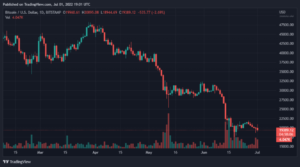Daniels Trading is nonpartisan and does not endorse political candidates. The purpose of this blog post is to provide objective, unbiased information on what we believe could happen in the markets. The content is not intended to convey a preference or state a position in support of any candidate, and the sentiments expressed do not necessarily reflect the viewpoints of our team members.
The 2020 U.S. presidential election was a historic event that brought record turnout and a contested outcome. Democratic candidate Joe Biden became the 46th president, and a new era of economic, environmental, and trade policy began. Perhaps the largest question about this new era among industrial and financial market participants pertained to the U.S.-China trade war timeline.
Read on to learn more about what 2021 may hold for U.S-China trade relations.
The Trump-Biden Transition
During his term, President Donald Trump aggressively engaged the issue of U.S.-China trade. Ultimately, the Trump administration’s efforts culminated in the signing of the Phase One U.S.-China Trade Deal, which outlined quotas for Chinese imports of U.S. agricultural goods, protections for intellectual property, and directives facing financial services. However, Phase One had been in effect for a little less than two months when the COVID-19 pandemic forced the world to reevaluate the basic tenets of global commerce.
During the Democratic presidential primaries, candidate Joe Biden was an outspoken critic of the Trump administration’s trade policy toward China. In a summer 2019 speech, Biden pulled no punches:
“President Trump may think he’s being tough on China. All that he’s delivered as a consequence of that is American farmers, manufacturers and consumers losing and paying more.”
However, once he became the president-elect, Biden stated that he was inclined to keep Phase One and existing tariffs in place:
“I’m not going to make any immediate moves, and the same applies to the tariffs. I’m not going to prejudice my options.”
Through Q1 and Q2 of 2021, Biden has kept his word. Although the U.S.-China trade war timeline remains vague, Phase One is the tenet governing commerce between the two superpowers. As of this writing, the following Phase One policies remain in place:
- U.S. tariffs: Twenty-five percent levies on $250 billion worth of Chinese industrial goods and component exports are active.
- China tariffs: Retaliatory tariffs on more than $100 billion in U.S. goods imports are still in play.
- Chinese imports: For 2020 and 2021, China is bound to satisfy pledges to increase the purchase of American goods and services by at least $200 billion.
U.S.-China Trade War Timeline: Will 2021 Bring a Return to Business as Usual?
Throughout the first 100 days of the Biden administration, many participants in the financial markets have been focused on tariff rollbacks and a restart of U.S.-China cooperation. As of May 2021, no moves were made on the trade front by the Biden administration. Nonetheless, new U.S. Trade Representative Katherine Tai made a few statements during spring 2021 that suggest the relative quiet was soon to change:
- On Phase One: “It’s the agreement that we have, it’s the agreement that we will work from, that we will build from.”
- On future policy: “I want to disconnect this idea that the only way we do affirmative trade engagement, trade enhancement is through a free trade agreement. Let’s think about flexibility.”
If Tai’s comments are to be taken at face value, then a hybrid approach to U.S.-China trade is likely. By the end of 2021, odds are that Phase One will exist in some form. Accordingly, issues such as tariffs and Chinese purchase commitments will be addressed, with concessions possible from both sides. Given the persistence of COVID-19 economic and social fallout, it’s difficult to project how U.S.-China negotiations will progress.
The first meeting between the top U.S.-China negotiators, Katherine Tai and Chinese Vice Premier Liu He, occurred on May 27, 2021. Press releases from the Office of the United States Trade Representative and Chinese Commerce Ministry were fairly optimistic on the dialogue and U.S.-China trade war timeline:
- U.S.: Ms. Tai and Mr. Liu “discussed the guiding principles of the Biden-Harris Administration’s worker-centered trade policy and her ongoing review of the U.S.-China trade relationship, while also raising issues of concern.”
- China: “Both sides held candid, pragmatic and constructive exchanges with an attitude of equality and mutual respect.”
So is the U.S.-China trade war over? No. Is there an end date in sight? No. But both sides are back at the negotiation table, and that provides a reason for optimism in 2021.
Trading the Trade War
It is difficult to overstate the complexities of the U.S.-China trade war timeline. A multitude of factors will impact negotiations, including COVID-19, Taiwan, and Hong Kong. At this point, relations between the two nations are strained.
If you’re going to be active in the futures and options markets, then you would do well to stay current on the state of U.S.-China relations. And to keep your trading strategies flexible and take advantage of changes in that relationship, you may want to consider the equities and metals contracts available from CME Group, the Intercontinental Exchange (ICE), and the Smalls. Download this comprehensive Micro, Mini, and Smalls comparison chart to explore market options that can help you achieve your trading goals.
- 100
- 2019
- 2020
- 2021
- active
- ADvantage
- Agreement
- All
- American
- among
- bbc
- BEST
- biden
- Billion
- Blog
- build
- business
- change
- China
- chinese
- CME
- CME Group
- CNBC
- code
- comments
- Commerce
- component
- Consumers
- content
- contract
- contracts
- COVID-19
- Current
- Donald Trump
- Economic
- Election
- environmental
- equality
- Event
- exchange
- Exchanges
- exports
- Face
- facing
- farmers
- financial
- financial services
- First
- Flexibility
- form
- Free
- future
- Futures
- Global
- goods
- Group
- hold
- Hong Kong
- How
- HTTPS
- HubSpot
- Hybrid
- ICE
- idea
- Impact
- Including
- Increase
- industrial
- information
- intellectual property
- issues
- Joe Biden
- LEARN
- Market
- Markets
- Members
- months
- moves
- MS
- Optimism
- Options
- pandemic
- persistence
- policies
- policy
- political candidates
- president
- President Donald Trump
- presidential
- presidential election
- press
- Press Releases
- project
- property
- purchase
- Q1
- Releases
- Reuters
- review
- Services
- Social
- spring
- State
- States
- stay
- summer
- support
- Taiwan
- tariffs
- The Persistence
- top
- trade
- Trading
- Trading Strategies
- trump
- u.s.
- United
- United States
- value
- war
- Work
- world
- worth
- writing






